Organic Nitrogen Compounds V: Amine Salts
Spectroscopy
The amine salt functional group contains ionic bonding, and is extremely polar, giving rise to a number of intense and uniquely placed peaks that are easy to identify for primary, secondary, and ter tiary amines.
The nitrogen of amines is basic, and can react with strong acids to form what are called amine salts. These compounds are very important in the pharmaceutical industry, as many active pharmaceutical ingredients are amine salts. The amine salt functional group contains ionic bonding, and is extremely polar, giving rise to a number of intense and uniquely placed peaks that makes them easy to identify. In this article, the amine salts of primary, secondary, and tertiary amines will be discussed.
This is the fifth installment in our examination of the infrared (IR) spectra of organic nitrogen-containing functional groups. In previous columns, I introduced the topic, and we studied the spectra of primary amines, secondary amines, tertiary amines, and nitriles (1–4). The nitrogen of amines possesses a lone pair of electrons. This lone pair is somewhat basic, and can react with strong acids to form what are called amine salts (5). Primary amines, secondary amines, and tertiary amines can react with strong acids to from what are called primary amine salts, secondary amine salts, and tertiary amine salts. The reactions of these three amines with hydrochloric acid to form amine salts is illustrated in Figure 1
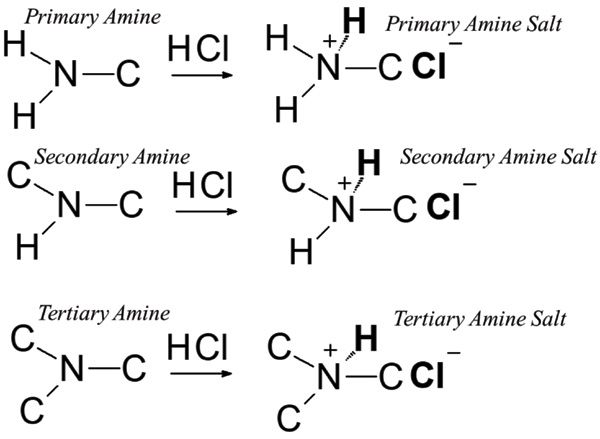
Figure 1: The reaction of a primary amine, secondary amine, and a tertiary amine with hydrochloric acid to form a primary amine salt, secondary amine salt, and a tertiary amine salt.
Note the unusual structure of amine salts seen in Figure 1. The lone pair of electrons on the amine reacts with the proton from the acid, forming a new N-H bond. Thus, the primary amine NH2 group is protonated to give a NH3+ unit, a secondary amine N-H is protonated to give a NH2+ functional group, and a tertiary amine is protonated to give a NH+ unit. As a result, the amine salt functional group is highly polar, with a positive charge on the nitrogen that is balanced by the negative charge from the anion of the acid. In the case of hydrochloric acid, this is the chloride ion, Cl–.
Recall that, in a classical acid-base reaction, one of the products is called a salt (5). For example, the reaction of HCl and NaOH literally gives salt (NaCl) and water. The reactions in Figure 1 are acid-base reactions, hence the designation of one of the products as an amine salt. Although many strong acids can be used to form amine salts, in my observation, hydrochloric acid is most frequently used. In this case, the amine salt is a hydrochloride salt, and the name hydrochloride is added to the name of the compound. For example, the reaction of methylamine with hydrochloric acid forms methylamine hydrochloride.
Because we have full positive and negative charges in the amine salt functional group, we have ionic bonding instead of the covalent bonding found in amines. Ultimately, we have two large charges separated by a distance, which means that amine salts have large dipole moments. Recall that one of the things that determines IR peak intensity is dµ/dx, the change in dipole moment with respect to distance during a vibration (6). Given that amine salts have large dipole moments, their vibrations have large values of dµ/dx, and so their spectra have intense peaks, as we will see below.
Amine salts are very important in medicinal chemistry, and any number of legal (and illegal) drugs contain the amine salt functional group. The reason for this is water solubility; a water soluble molecule is more easily taken in by the human body, and is more bioavailable than a water insoluble molecule. Many drug substances are large organic molecules, which tend to be nonpolar and water insoluble. Additionally, many drug substances contain amine groups. By simply reacting the drug molecule's amine functional group with a strong acid like HCl, the amine salt is formed, and the compound is rendered water soluble, and thus more bioavailable.
Being able to distinguish amines from amine salts even has legal implications. Cocaine is found in two forms, the hydrochloride amine salt and the amine or "free base" with the street name crack cocaine (7). In the United States, possession of these two illicit substances carries different penalties, as the crack version is considered more dangerous. One of the major uses of Fourier transform infrared spectroscopy (FT-IR) in forensic labs is distinguishing cocaine hydrochloride from cocaine. Fortunately, this is easy as can be seen in Figure 2, which shows an overlay of the IR spectra of cocaine base and cocaine HCl.
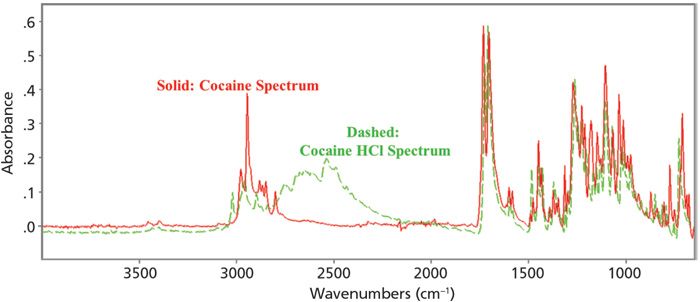
Figure 2: An overlay of the infrared absorbance spectra of cocaine and cocaine HCl.
The IR Spectra of Amine Salts
Overview
In addition to intense peaks, we would expect amine salts to have broad peaks as well. Recall that, in IR spectra, peak width is determined by the strength of intermolecular bonding (6). Nonpolar functional groups, like benzene rings, have narrow peaks, while molecules that have strong intermolecular bonds, such as water, which is hydrogen bonded, have broad peaks (6). Amine salts are highly polar; their molecules interact strongly producing very broad peaks. This is seen in the spectrum of cyclohexylamine hydrochloride in Figure 3.
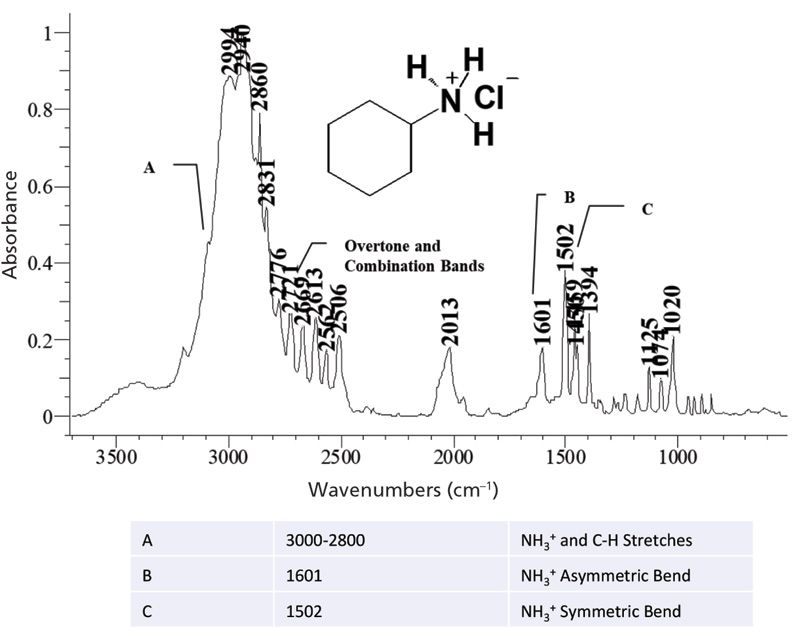
Figure 3: The infrared absorbance spectrum of cyclohexylamine hydrochloride.
The tall and broad feature labeled A centered near 3000 cm-1 (going forward, assume all peak positions listed are in cm-1 units, even if not specifically stated) is an envelope of absorbance due to the stretching vibrations of the NH3+ group. All amine salt spectra exhibit a broad envelope, like the one seen in Figure 3, which we will generically call the "NH+ stretching envelope." This feature is broad enough, intense enough, and appears at an unusual enough position that, by itself, can be indicative of the presence of an amine salt in a sample. The position of this envelope varies with the type of amine salt, as discussed below.
The right-hand side of this envelope has superimposed upon it a number of peaks that are due to overtone and combination bands. Recall that overtone and combination features are usually weak (8). However, in the case of amine salts, their high polarity means that the dµ/dx values for these overtone and combination vibrations are large enough for these peaks to appear easily in the spectra of amine salts.
A note on the spectra of anions in amine salts: For hydrochloride salts, where the anion is the chloride or Cl– ion, due to its mass, peaks from vibrations involving this ion generally fall below 400, where most FT-IR spectra cut off. However, amine salts made from acids with polyatomic anions, such as sulfuric acid, do exhibit anion peaks in the mid-IR region. This is illustrated by the spectrum of d-amphetamine sulfate, which is made by reacting amphetamine with sulfuric acid, and whose spectrum is seen in Figure 4.
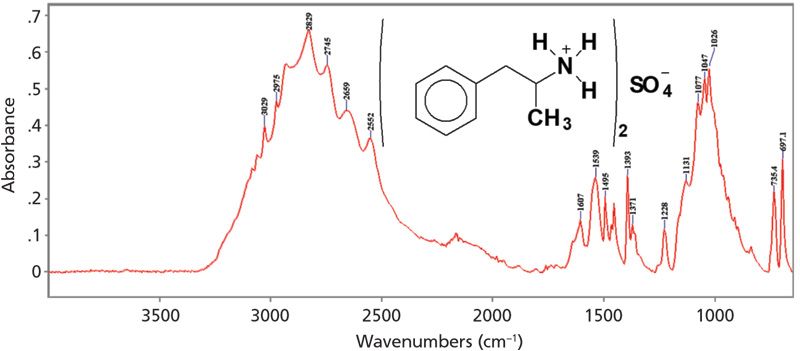
Figure 4: The infrared absorbance spectrum of d-amphetamine sulfate.
The broad envelope centered around 1050 is due to the stretching of the bonds in the SO4–2 unit. The even broader envelope that extends from 3500 to 2000 is the NH+ stretching envelope.
Primary Amine Salt Spectra
A primary amine salt features the NH3+ unit, with the resultant broad intense NH+ stretching envelope seen in Figure 3. For primary amine salts, generally this envelope falls from 3200 to 2800. We already know that alkane C-H stretches also fall in this region (9). As is common in IR spectroscopy (10), if a broad peak and a narrow peak fall in the same wavenumber range, the narrow peak may be seen on top of or as a shoulder on the broader peak. This is why the CH2 stretches of the cyclohexyl group sit on top of the NH+ stretching envelope. As already mentioned, there is a series of overtone and combination bands on the right hand side of the NH3+ stretching envelope. These features are common for all amine salt spectra, and the fall in the range from 2800 to 2000. Recall that carboxylic acids have a similar series of overtone and combination bands in this region, also caused by the extreme polarity of this functional group (11).
Table I lists the N-H stretching envelope positions for the three different types of amine salts. Note that there is some overlap, particularly between primary and secondary amines.
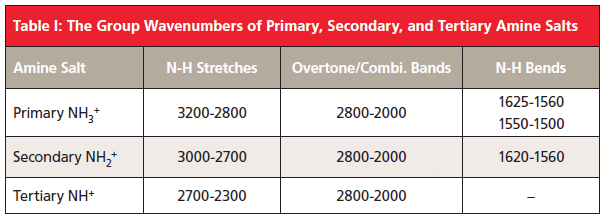
This means that the position of the NH+ stretching envelope will not always disclose whether an amine salt is primary, secondary, or tertiary. So what are we to do?
Fortunately, like many other functional groups, amine salts have multiple IR features, and these come to the rescue here. In addition to NH+ stretching vibrations, amine salts also have NH+ bending vibrations as well. The NH3+ grouping of primary amine salts features two peaks from the asymmetric and symmetric bending vibrations, labeled B and C in Figure 2. In general, the asymmetric bend falls from 1625 to 1560, and the symmetric bend from 1550 to 1500. Strangely enough, these peaks are small in sharp contrast to the intense NH+ stretching envelope. This is all due to the difference in dµ/dx between the stretching and bending vibrations of the amine salt functional group.
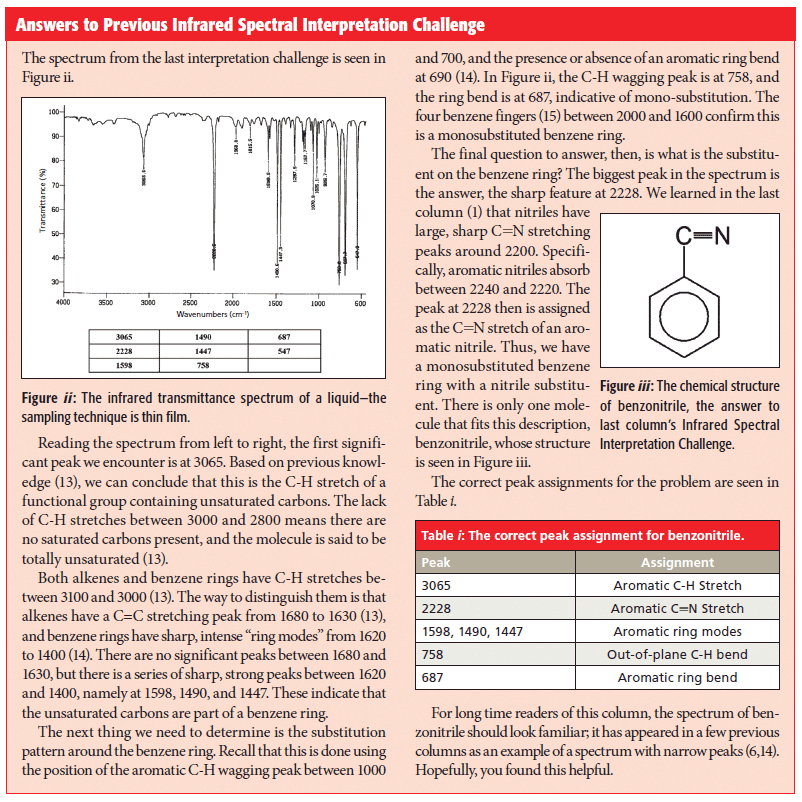
Secondary Amine Salt Spectra
Secondary amine salts contain the NH2+ group. The IR spectrum of a secondary amine salt, diisopropylamine hydrochloride, is seen in Figure 5.
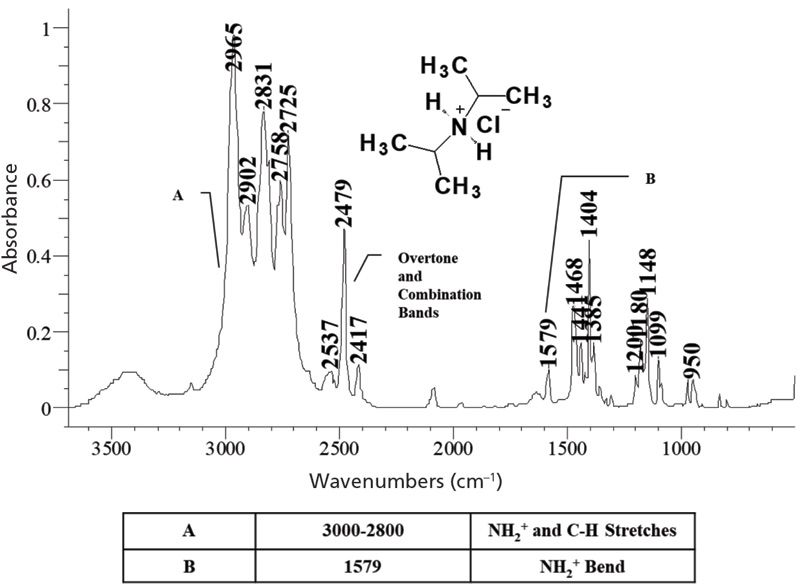
Figure 5: The infrared absorbance spectrum of a secondary amine salt, disopropylamine hydrochloride.
The NH+ stretching envelope is labeled A. Note that it is broad and strong, like the ones seen in Figures 3 and 4. As in Figure 3, the C-H stretches here also fall on top of the NH+ stretching envelope. It also has the expected complement of overtone and combination bands on its lower wavenumber side. For secondary amine salts in general, this envelope is found from 3000 to 2700. Note that there is some overlap between the envelopes of primary and secondary amines. However, secondary amine salts only have one NH+ bending band compared to primary amine salts. This feature typically falls from 1620 to 1560, and is labeled B in Figure 5. Thus the position and number of NH+ bending bands is what determines whether a sample contains a primary or secondary amine salt.
Tertiary Amine Salt Spectra
Tertiary amine salts contain the NH+ group, as seen in Figure 1. The IR spectrum of a tertiary amine salt, 2,2',2''-trichloroethylamine hydrochloride, is seen in Figure 6.
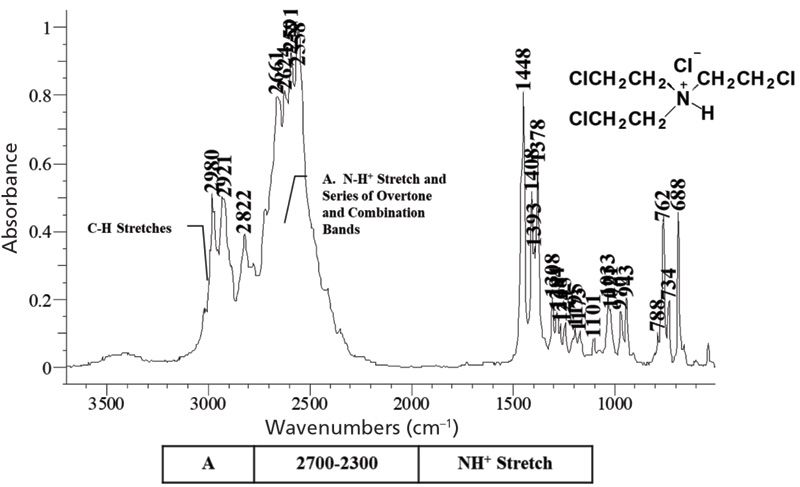
Figure 6: The infrared absorbance spectrum of a tertiary amine salt, 2,2',2''-trichloroethylamine hydrochloride.
The NH+ stretching envelope is Figure 6 is labeled A. Note that it is lower in wavenumber than for primary and secondary amine salts, and that the C-H stretches fall as shoulders to left of the envelope peak. Given that the NH+ stretching envelope for tertiary amines falls squarely in the overtone-combination range from 2800 to 2000, these peaks show up on top of and as shoulders to the right of the NH+ stretching envelope. In general, for tertiary amine salts, this envelope falls from 2700 to 2300. The size, width, and position of this peak is practically unique in IR spectroscopy-in my decades of experience, I have never seen a peak like it (10). Thus, this peak by itself is strongly indicative of their being a tertiary amine salt in a sample. Tertiary amine salts do not have any NH+ bending peaks, so the lack of peaks from 1625 to 1500 can also be used to distinguish tertiary amine salts from primary and secondary salts.
We discussed previously that tertiary amines have no strong, unique peaks, and thus are difficult to detect using IR spectroscopy (12). This contrasts with tertiary amine salts, whose NH+ stretching envelope sticks out like a sore thumb. A way of detecting a tertiary amine in a sample then is to treat 1 mL of liquid tertiary amine, or tertiary amine dissolved in an organic solvent, with 1 mL of 50:50 HCl in ethanol. If there is a tertiary amine present, the amine salt will form and precipitate as a solid from solution (12). Collect the precipitate via filtration, dry, and measure its IR spectrum. If you see a big, whopping NH+ stretching envelope like the one seen in Figure 6, your original sample contained a tertiary amine.
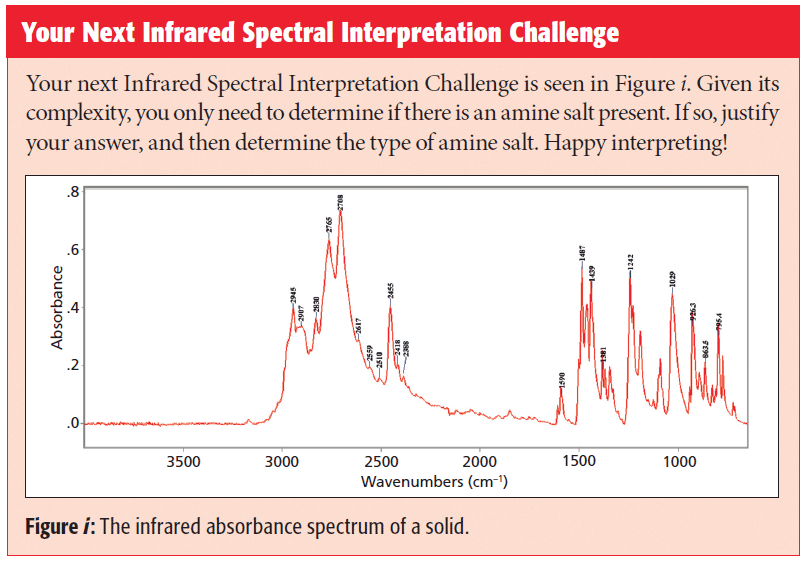
The group wavenumber peaks for amine salts are listed in Table I.
Conclusions
Amine salts are made by reacting amines with strong acids. Primary amine salts contain the NH3+ group, secondary amine salts the NH2+ group, and tertiary amine salts the NH+ group. Amine salts are important, because they are used to make drug substances water soluble, and hence more bioavailable.
All amine salts contain an intense, broad NH+ stretching envelope that is a rather unique infrared feature. The envelope position overlaps for primary and secondary amine salts, but is unique for tertiary salts. Primary and secondary amine salts can be distinguished by the number and position of NH+ bending peaks.
References
(1) B.C. Smith, Spectroscopy34(7), 18–21, 44 (2019).
(2) B.C. Smith, Spectroscopy34(5), 22–26 (2019).
(3) B.C. Smith, Spectroscopy34(3), 22–25 (2019).
(4) B.C. Smith, Spectroscopy34(1), 10–15 (2019).
(5) A. Streitweiser and C. Heathcock, Introduction to Organic Chemistry (MacMillan, New York, New York, 1st ed., 1976).
(6) B.C. Smith, Spectroscopy30(1), 16–23 (2015).
(7) https://en.wikipedia.org/wiki/Cocaine
(8) B.C. Smith, Spectroscopy31(7), 30–34 (2016).
(9) B.C. Smith, Spectroscopy30(4), 18–23 (2015).
(10) B.C. Smith, Infrared Spectral Interpretation: A Systematic Approach (CRC Press, Boca Raton, Florida, 1999).
(11) B.C. Smith, Spectroscopy33(1), 14–20 (2018).
(12) B.C. Smith, Spectroscopy33(3), 16–20 (2018).
(13) B.C. Smith, Spectroscopy31(11), 28–34 (2016).
(14) B.C. Smith, Spectroscopy31(5), 36–39 (2016).
Brian C. Smith, PhD,

Brian C. Smith, PhD, is founder and CEO of Big Sur Scientific, a maker of portable mid-infrared cannabis analyzers. He has over 30 years experience as an industrial infrared spectroscopist, has published numerous peer reviewed papers, and has written three books on spectroscopy. As a trainer, he has helped thousands of people around the world improve their infrared analyses. In addition to writing for Spectroscopy, Dr. Smith writes a regular column for its sister publication Cannabis Science and Technology and sits on its editorial board. He earned his PhD in physical chemistry from Dartmouth College. He can be reached at: SpectroscopyEdit@MMHGroup.com
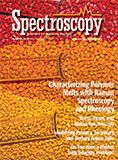
AI Shakes Up Spectroscopy as New Tools Reveal the Secret Life of Molecules
April 14th 2025A leading-edge review led by researchers at Oak Ridge National Laboratory and MIT explores how artificial intelligence is revolutionizing the study of molecular vibrations and phonon dynamics. From infrared and Raman spectroscopy to neutron and X-ray scattering, AI is transforming how scientists interpret vibrational spectra and predict material behaviors.
Real-Time Battery Health Tracking Using Fiber-Optic Sensors
April 9th 2025A new study by researchers from Palo Alto Research Center (PARC, a Xerox Company) and LG Chem Power presents a novel method for real-time battery monitoring using embedded fiber-optic sensors. This approach enhances state-of-charge (SOC) and state-of-health (SOH) estimations, potentially improving the efficiency and lifespan of lithium-ion batteries in electric vehicles (xEVs).
New Study Provides Insights into Chiral Smectic Phases
March 31st 2025Researchers from the Institute of Nuclear Physics Polish Academy of Sciences have unveiled new insights into the molecular arrangement of the 7HH6 compound’s smectic phases using X-ray diffraction (XRD) and infrared (IR) spectroscopy.